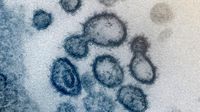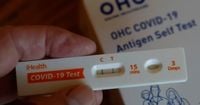On April 18, 2025, the Trump White House launched a new website that has transformed the previously informative covid.gov into a platform promoting the controversial theory that the COVID-19 pandemic originated from a laboratory leak in Wuhan, China. This significant redesign has drawn attention and criticism, as it shifts focus from public health guidance to political narratives surrounding the origins of the virus.
The new webpage, titled "Lab Leak: The True Origins of COVID-19," prominently features an image of President Donald Trump, walking between the words "lab" and "leak." It claims that Wuhan is home to a research lab with a history of conducting virus research under "inadequate biosafety levels." The site alleges that Dr. Anthony Fauci, the former director of the National Institute of Allergy and Infectious Diseases, pushed a "preferred narrative" suggesting that COVID-19 originated in nature.
According to a U.S. intelligence analysis released in 2023, there is insufficient evidence to definitively prove either the lab leak theory or the natural origin theory. Despite this, the Trump administration's new website asserts that the lab leak is the most likely explanation for the pandemic, echoing a report from the GOP-led House Select Subcommittee on the Coronavirus Pandemic released in December 2024. This report, which spans over 500 pages, has been referenced extensively on the new site.
In a statement to Fox News Digital, a senior administration official emphasized the importance of transparency, saying, "The American people deserve to know the truth about the COVID pandemic, and we will always find ways to reach communities with that message." The webpage criticizes public health officials for what it describes as misleading the public and disfavoring alternative narratives, including the lab leak theory, in an effort to control health decisions.
This overhaul of the covid.gov website is not the first instance of the Trump administration reshaping government communication. Previous administrations have also made changes to federal websites, but the extent of this transformation has raised eyebrows. The new site has prompted renewed enthusiasm among conservative circles, with some Republican representatives, such as Rep. Mariannette Miller-Meeks (R-Iowa), expressing support for the narrative that the "truth is coming to light." However, there remains a lack of consensus among scientists and officials regarding the origins of the virus.
Experts have cautioned that the ongoing debate over whether the virus jumped from animals to humans or leaked from a lab distracts from the broader goal of preventing future pandemics. Mun-Keat Looi, features editor for the BMJ medical journal, noted last year that the trail for definitive scientific evidence is "cold," largely due to the Chinese government’s refusal to share data and cooperate with international investigations.
Furthermore, former National Institutes of Health Director Francis Collins highlighted the complexities of tracing the origins of viruses, stating, "Confirming with 100% certainty the origin of a virus is a long and complicated process." He referenced the lengthy investigations that have been necessary for other outbreaks, such as SARS and Ebola.
In the wake of the website’s launch, public health data has also been scrubbed from federal sites, with reports indicating that the Pentagon removed photos celebrating diversity, equity, and inclusion. The previous covid.gov site offered crucial information about ordering free COVID tests, vaccination updates, and treatment options for those who fell ill. Currently, about 325 Americans are dying from COVID-19 each week, according to the U.S. Centers for Disease Control and Prevention (CDC), while less than a quarter of adults in the U.S. have received an updated COVID vaccine as of early April 2025.
As the political landscape continues to shift, the Trump administration's new focus on the lab leak theory reflects a broader narrative among conservatives, who have criticized the previous administration's handling of the pandemic. The website's claims have been met with skepticism from many scientists, who argue that the evidence for a natural origin remains strong. The ongoing debate around the origins of COVID-19 has significant implications for public health policy and trust in governmental institutions.
In addition to the changes to the covid.gov website, federal agencies have been directed to remove COVID-19 signage from their buildings. A memo obtained by CBS News indicates that this directive was issued in early April 2025, following the end of the Federal COVID-19 Public Health Emergency declaration on May 11, 2023. This memo also instructed agencies to display official portraits of President Trump and Vice President J.D. Vance, while removing those of the previous administration.
Critics of the new website have expressed concern that it may further erode public trust in health agencies and scientific institutions. Amesh Adalja, an infectious disease physician at Johns Hopkins, criticized the decision to replace public health information with politically motivated content, stating that the origins of the pandemic remain an open question. He emphasized that both the lab-leak and natural origin theories should be investigated thoroughly.
As the Trump administration continues to push its narrative, the implications for public health and scientific inquiry remain profound. The debate over COVID-19's origins is not just a matter of historical interest; it shapes how the U.S. will respond to future pandemics and the level of trust the public has in its health officials. The current political climate, characterized by sharp partisan divides, complicates the pursuit of scientific truth and effective public health policy.
In conclusion, the launch of the new website has reignited discussions about the origins of COVID-19 and the role of government communication in shaping public perception. As the nation grapples with the aftermath of the pandemic, the need for clear, accurate information has never been more critical.









